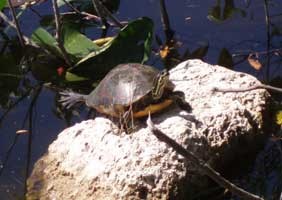
Shhhh... do you hear something? Whether you're looking for the large alligator, a really cool slithering snake, turtles with hard shells on their backs, or the numerous small lizards that can be found almost everywhere in the south, know that you'll likely see that and more here in the Everglades! Your just have to know where to look! Reptiles seem to prefer warmer climates because they are cold blooded (just like amphibians). Remember, cold blooded means they must rely on their surrounding environments to regulate or maintain their body temperatures. 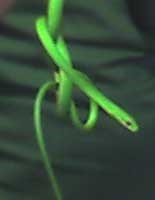
Being cold blooded means they can go for much longer without eating than we warm blooded creatures can. That’s because warm blooded animals are constantly using their energy to keep their bodies at a comfortable temperature. It's also why on a cold winter day, you’ll burn up a lot more energy trying to keep warm than on a warm day in the spring. Being cold blooded means you can save your energy and use it for other things, like growing bigger! ~Alligators can reach a foot long within their first year.~ 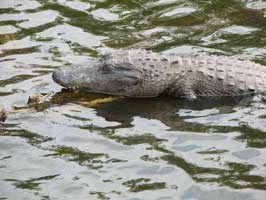
However, not everything is great for cold blooded animals. Imagine trying to get up in the morning in winter if you were cold blooded. Moms everywhere would have an impossible time getting their kids out of their warm beds and ready for school outside! Reptiles face this problem every time the temperature drops or when it gets really cloudy. It takes them a long time just to warm up enough to be able to move.
If you are a tiny reptile, (like a lizard or snake) you could have even more trouble on days like this. If it is too cold, they won't be able to move that fast and some warm-blooded animal might come looking for a snack. Yikes! 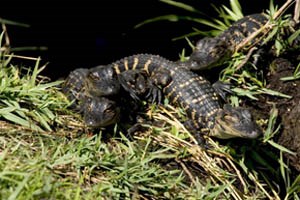
Reptiles also lay eggs like birds and amphibians. Their eggs have shells so they don’t have to be laid in water like amphibian eggs. When the eggs hatch, the babies tend to look like miniature copies of their parents (with maybe a slight difference in color). Take a look at the baby alligators in this picture. They look like tiny adult alligators right? You can also see that their skin has some yellow striping on their backs which helps them blend in with the grasses or camouflage with their surroundings. Now that we've learned about reptiles, let's take some time to look at some of the Everglades’ reptiles. 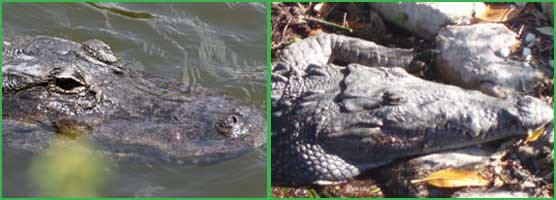
What would the reptile group be without the Crocodilian family and its members, the alligators and crocodiles! Here in the Everglades, you can find both the American alligator and the American crocodile if you know where to look. However, which animal is which? Can you tell the difference between an alligator and a crocodile? Test out your skills and try to guess which one is the alligator. If you guessed the large reptile on the left you are CORRECT! When identifying a crocodillian, it helps to look for key features such as:
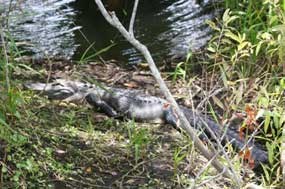
Alligators have a U-shaped snout and when their mouths are closed, the only teeth you might see are the ones pointed down. Now, I want you to take a good look at that gator. Close your eyes and without peeking try to remember what color its skin is. Did you get it right? Alligators have dark gray to black skin, never green. Many people think an alligator has green skin, but as you can see, myth is not true. The darker color is helpful to that alligator when it tries to camouflage, or blend into its surroundings. The skin color also helps it absorb heat from the sun (remember, it needs this because it is cold blooded). Think about this, if you were standing in the sun which shirt would be hotter... a navy (dark blue) or white t-shirt? That's right, it would be the navy blue shirt. Lastly, where would you expect to find an alligator, in freshwater or saltwater? 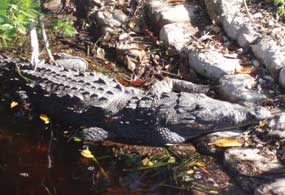
Here is the American crocodile! You can tell it's a crocodile, because his snout is V-shaped (remember the alligator has a U-shaped snout). Crocodiles' skin also tends to be more olive/gray in color. It might also help you to know where crocodiles can be found. Would you expect them to hang out in fresh or saltwater? So, if you want a chance to spot this rare and endangered reptile you would have a better chance near the coast. Remember endangered means there are not many left. 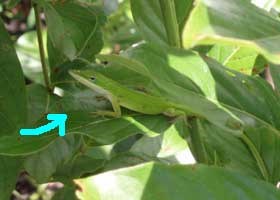
Another reptile you would expect to see in Florida would be the native green anole. The green anole is a lizard that is sometimes called a chameleon because of its ability to change skin color from green to brown. However, it is not a true chameleon. Changing the color of its skin allows it to better blend into its surroundings (also called camouflage). This makes it more difficult for predators to spot it. Sometimes you may even spot some nonnative species of reptiles in the Everglades.
To return to the previous page click on Wildlife and to return to the main |
Last updated: April 14, 2015
